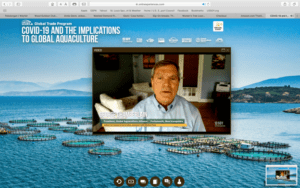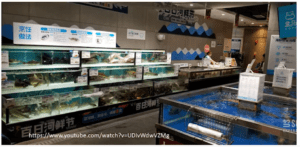 Aquaculture demand is growing globally despite the impact of the COVID-19 pandemic, according to George Chamberlain, president of the Global Aquaculture Alliance (GAA). He shared the Impact of COVID-19 on Aquaculture during the digital conference COVID-19 and the Implications to Aquaculture, hosted by the U.S. Soybean Export Council (USSEC) in late May.
Aquaculture demand is growing globally despite the impact of the COVID-19 pandemic, according to George Chamberlain, president of the Global Aquaculture Alliance (GAA). He shared the Impact of COVID-19 on Aquaculture during the digital conference COVID-19 and the Implications to Aquaculture, hosted by the U.S. Soybean Export Council (USSEC) in late May.
“It’s important to note that COVID-19 does not infect seafood itself, but it has many indirect impacts on the seafood sector,” Chamberlain said.
He discussed the impacts of the global pandemic on aquaculture’s market channels, logistics, worker safety and production. Then he summarized expected short-term, mid-term and long-term outlooks for the industry.
Changing Market Channels
The closure of the food service sector led to a great increase in seafood consumption at retail and through e-commerce. Previously, restaurants, catering and hotels in countries like the U.S. and wet markets, especially in Asia, had been the major source of seafood consumption.

“Asian customers are learning that fresh fish from retail and e-commerce is just as good and even more convenient than live fish,” Chamberlain explained. “And Western consumers are learning to prepare seafood at home, so eventually when food service opens again, total consumption should be even higher.”
He highlighted Alibaba’s Hema markets in China as a new retail concept for seafood. An e-commerce giant, Alibaba currently has 65 of these retail outlets.
“They basically are connecting the retail experience with their e-commerce app, which connects the user to the full providence of every product just by scanning the barcode on any particular product,” he said. “A restaurant delivers product by robot. They can deliver to customers within three kilometers, within 30 minutes of the order. And of course, checkout is automatic. It’s a fascinating concept.”
Supply Chain Disruptions
COVID-19 also impacted the logistics of the aquaculture supply chain. At the local level, movement controls prevented workers from getting to their jobs, slowing business around the world. International air travel essentially shut down, resulting in reduced air freight capacity and significant increases in air freight prices. This impacted species like lobster, salmon, sea bass and tilapia raised for the fresh export market.
“We have situations where premium fish are ready for harvest, but there’s no market to receive them, and the fish are too expensive or inappropriate for domestic sale,” he said.
The pandemic also affected worker safety in seafood processing plants, where employees work in close proximity along conveyor belts. COVID-19 spreads easily in this environment, although these issues were experienced at a lesser degree that the pork, beef and poultry processing plants in the U.S.
During the pandemic, drops in prices and production impacted fisheries around the world. However, as countries slowly open back up, production and logistics will return to normal.
Looking Ahead: Future of Aquaculture
Chamberlain said the near-term outlook for aquaculture is challenging. “Consumer budgets are expected to be tight with all the unemployment, so expensive seafood items may suffer,” he said. However, growth in retail and e-commerce are promising.
“In the mid-term, we expect some positive benefits from this COVID-19 technology boom,” Chamberlain continued. “There’s improvements in in diagnostic technology, rapid diagnostics, vaccines for production and processing mechanization for worker health and safety.

He also described adoption of production technology like the In-Pond Raceway System (IPRS) introduced in many countries by USSEC. The system improves sustainability and water quality. Incorporating soy protein into rations as a renewable feed source also supports the sustainability of fisheries.
Continuous sustainability improvements are a high priority throughout the aquaculture industry. GAA is investigating the opportunities for green financing to support these types of advances. Aquaculture can be eligible for funds association with environmental improvements. These green loans can be an opportunity to leverage Best Aquaculture Practices (BAP) certification to support financing for ongoing sustainable improvements.
“In the long term, we can expect the global population to increase which will mean greater food and protein demand in the future that cannot be met by today’s food systems,” he concluded. “Aquaculture is well positioned to address these challenges with healthy foods produced from environmentally and socially responsible systems.”
